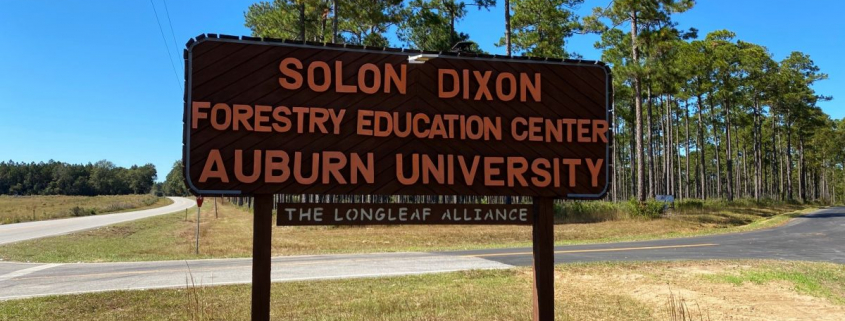Managing Longleaf Pine at Auburn University’s Solon Dixon Forestry Center
October 15, 2022, I spent the afternoon (and the following morning) visiting Auburn University’s Solon Dixon Forestry Education Center, where I had last been in 1984 when I served as Alabama Land Manager for Union Camp Corporation. My visit served as a celebratory reunion. Rhett Johnson, who hosted my 1984 tour and served as Solon Dixon Director for 26 years, likewise hosted my October return. Emmett Thompson, Auburn Dean Emeritus, College of Forestry, Wildlife, and Environment, and his son-in-law Ken Pylant also accompanied us. I worked closely with Emmett, who was then Dean, when I served as Director, Alabama Cooperative Extension System 1996-2001.
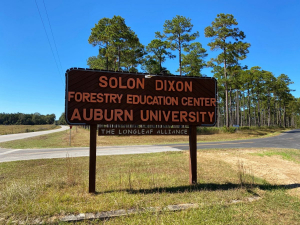
My excitement for re-visiting the The Solon Dixon Center brought back lots of memories, renewed long friendships, and reignited my passion for longleaf pine, a forest type that once extended across 92 million acres from southeastern Virginia to east Texas.
America’s Richest Forest
I left the Center with a signed copy of Rhett’s (along with Bill Finch, John C. Hall, and Beth Maynor Young) Longleaf, Far as the Eye Can see, a coffee-table-quality treasure that I will cherish! The book carries a tantalizing subtitle: A New Vision of America’s Richest Forest.
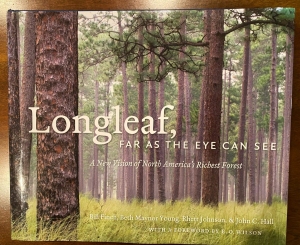
From the book:
In colonial times, the longleaf turned out to be very valuable for lumber and for the pitch, tar and turpentine made from the trees and believed to be the origin of North Carolina’s moniker, “Tar Heel State.” Eighteenth-century ships were made entirely of wood, and North Carolina was called upon to provide so-called “naval stores” including tar, pitch and turpentine that were used to keep ship bottoms waterproof and afloat.
Of course, much has changed in the South over the last 500 years. A survey conducted in 1996 by a Florida researcher found that less than 0.01 percent of the remaining longleaf pine forests could be considered old growth. This handful of virgin forests is a draw for scientists, serving as a benchmark for conditions prior to European settlement.
Only about one percent of their original range remains. Longleaf pine communities may have covered some 92 million acres across its natural range, but now fewer than 3 million acres remain.
Rhett updated the longleaf acreage numbers as we toured the property, indicating that the total acreage had dropped to 2.5 million and now, resulting from dedicated efforts across the south, stands at six million!
Longleaf is a long-lived species, kept vibrant with periodic fire. This stand may be two hundred years old, with widely-spaced overstory, scattered mid-story trees of lower age classes, and fire-dependant herbaceous ground vegetation.
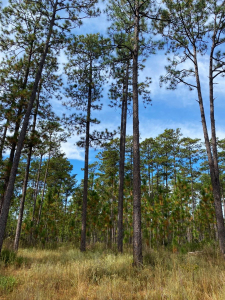
William Bartram described such “high pine forests, dark and grassy savannas” from his wanderings 230 years ago. Well over 100 years ago, John Muir spoke of his travels in the longleaf forests:
“In ‘pine barrens’ most of the day. Low, level, sandy tracts; the pines wide apart; the sunny spaces between full of beautiful abounding grasses, liatris, long, wand-like solidago (goldenrod), saw palmettos, etc., covering the ground in garden style. Here I sauntered in delightful freedom, meeting none of the cat-clawed vines, or shrubs, of the alluvial bottoms.”
The longleaf forest energizes me…reminds me of the two-century dynamic intersection of human and natural history as the new nation emerged in part by the thrust provided via a vast rich forest and the industry it supported. My own professional life launched and flourished during the 12 years I worked for Union Camp. Our company-owned Chapman Forest constituted 220,000 acres of intensively managed loblolly pine and associated hardwood stands in adjoining riparian areas in a five-county area of south-central Alabama, south of the black belt physiographic region. The loblolly had replaced original stands of longleaf. As a Fortune 500 paper and allied products manufacturing company, Union Camp’s forest management emphasized fiber production, for which loblolly best satisfied the objective.
Our Chapman Forest offices in Butler County stood within an old growth longleaf grove, which included several federally endangered red cockaded woodpecker colony trees. The nests at our location had been excavated 60-70 feet high in live trees. The birds keep the sap flowing to ward off snakes and other predators from their eggs and young…and to trap tasty insects.
(Stock image from internet)
The forest type extended northward to the southeast Virginia coastal plain, yet I do not recall encountering longleaf pine on the forests I managed there during the seven years I worked with Union Camp in that region. I would love to have seen the vast longleaf forest that stretched across the South prior to European settlement.
The Solon Dixon Legacy
Rhett and Emmett shared stories of the Center’s namesake. Rhett gave me a copy of The Dixon Legend. Mr Dixon was a genuine legend from another era, a man who loved the land and its pine, and who left a lasting legacy through Auburn University.
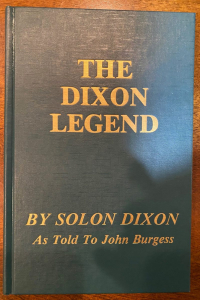
Emmet (center), Rhett, and I stand in front of Mr Dixon’s family home, “built in the 1850’s and moved to its current site in the 1870’s.” It is “framed with locally milled pine… The home features hand-planed boards on the walls and ceiling… Originally surrounded by outbuildings related to the Dixon’s forestry operations, the Dixon home is now the center of the Solon Dixon Forestry Education Center.
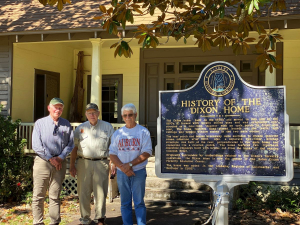

“Four generations of Dixons, each promoting the management of trees as a renewable resource, made their living in forestry on this ground, thereby contributing significantly to Alabama’s economy and forest industry… Solon and Charles (Solon’s brother), both raised in this home, became successful forest product industrialists and recognized conservationists.”
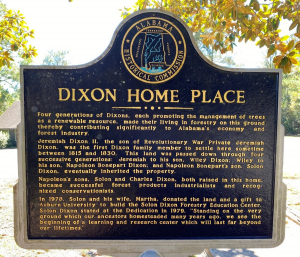
“In 1978, Solon and his wife Martha, donated the land and a gift to Auburn University to build the Solon Dixon Forestry Education Center. Solon stated at the dedication in 1979, “Standing on the very ground which our ancestors homesteaded many years ago, we see the beginning of a learning and research center which will last far beyond our lifetimes.” The Solon and Martha Dixon Foundation Learning Center stands nearby.
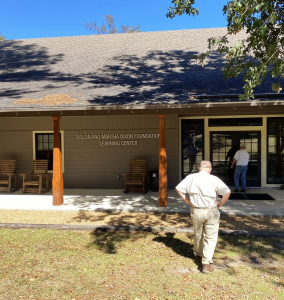
A state of the art auditorium bears Rhett’s name as well as Dean Gerstad, a now retired Auburn forestry faculty member who dedicated his professional life to advancing longleaf pine science and practice.
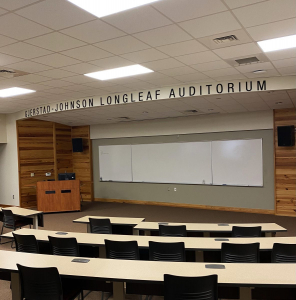
Many former Auburn forestry students recall their undergraduate summer at forestry camp, conducted at the Center under Rhett’s tutelage. They all remember The Box where during Camp Rhett housed various and sundry snakes he collected on the property. I’m told that The Box served as the nexus for frequent snake-related harmless practical jokes!
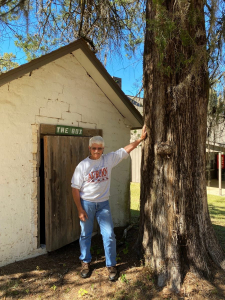
Re-establishing Longleaf Pine
The Center and the allied Longleaf Alliance are striving to re-establish longleaf throughout its historic range. For example, the Bankhead National Forest in northwest Alabama, within the species’ natural range, plans to eventually convert one third of its pine uplands to longleaf. Similar efforts are accelerating across south Alabama.
Late in the afternoon October 15, 2022, we visited an area where the Solon Dixon crews are converting a mixed mature forest to longleaf pine. Following timber harvest, staff employed herbicide and fire as site preparation before planting longleaf seedlings. The planted trees have completed two growing seasons.
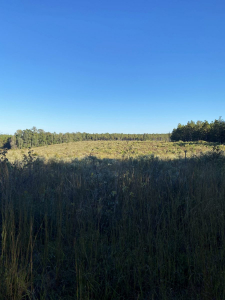
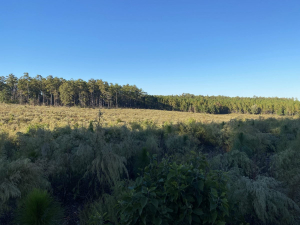
Longleaf can spend 1-4 years in the grass stage (below left) before sending up a first “candle” (below right).
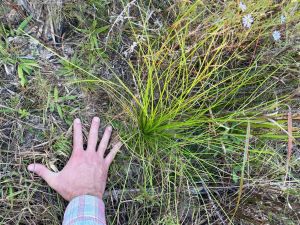
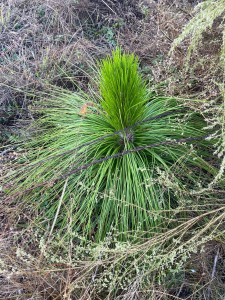
Below left Rhett is showcasing a vigorous individual that candled in season one. My three fellow observers are standing at the edge of the converted area. Older longleaf borders the new stand.
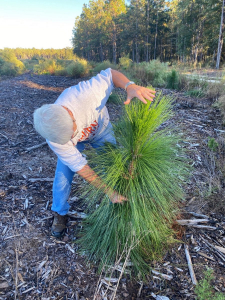
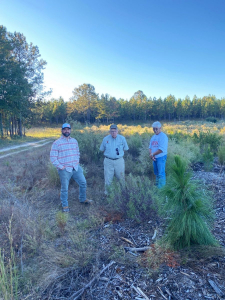
I recorded this 1:44 video at the longleaf-regenerated clearcut:
Lasting Evidence of a Dying Operation and Trade
As we approached noon October 16, I snapped this photo of a loblolly pine plantation adjacent to a mature longleaf stand, one old enough to retain turpentine faces from naval stores operations decades ago. From the Southern Forest Heritage Museum website:
Naval stores are a nearly forgotten legacy in the South, but throughout history nations have depended on them, sought them out, and fought wars over these resins from pine trees. These products—tar, pitch, turpentine, and rosin—long kept wooden ships of the world afloat and were found to provide other uses prior to the petrochemical dominance. Even with the decline in sailing ships, there has been an international demand for these products.
The story of naval stores is remarkable and messy, but the industry helped support much of the South’s economy for nearly 400 years. Naval stores operations, which involved scoring the tree cambium, was slow to develop in Western Gulf states. The largest naval stores operations in these western states occurred following the harvest of the virgin pine forests. The resinous stumps that remained were harvested, chipped, and steamed to obtain the same chemicals that had been obtained by chipping live trees.
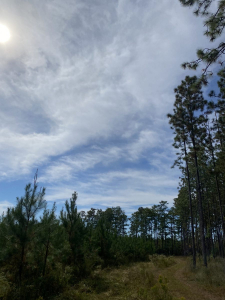
We stopped at this old stand at sunset our first day. An old naval stores face is visible at the base of the tree at the left margin.
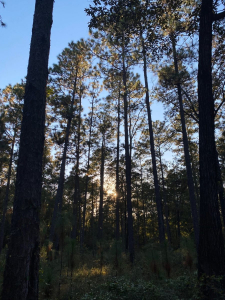
This scar (below left) is callousing over, yet the sap drip collar is still present. The same tree stands at right, its coarse branching and flattened crown are typical of old longleaf.
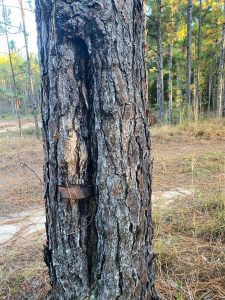
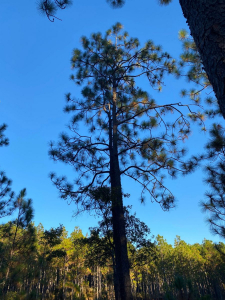
Here is another scarred face with an aluminum nail for hanging the collection bucket under the drip collar. Below right shows yet another old face on a tree still vibrant enough to actively callous the old wound.

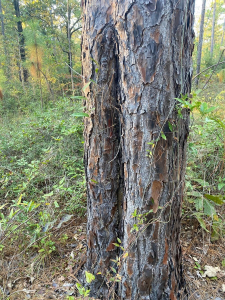
Back at the Center Rhett show us an interior view of a working face. The view is from the tree’s perspective looking out to the scoring.
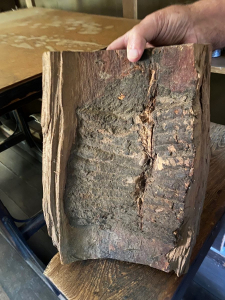
Here is another morning view into an old growth longleaf forest. This one appears to be overdue for a prescribed fire. An understory of woody vegetation has developed. I find the combination of forest, cerulean sky, and wispy cirrus irresistible.
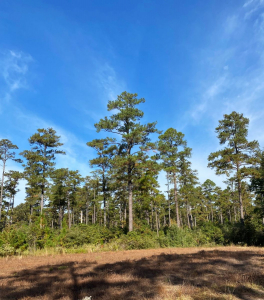
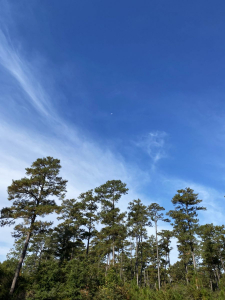
Reuniting with Emmett and Rhett at the Solon Dixon Center, under the spectacular second morning sky, brought me squarely back to my forestry roots. My retirement wanderings have rewarded me over and over again. My eyes see far more today than they did during my younger, career-driven woodland explorations. In part, today I know well that Nature’s beauty, magic, wonder, and awe often lie hidden in plain sight. I now know better how to look so that I may see…and understand. Seeing and understanding open the door to appreciation and inspiration. Inspiration is a portal to lifting my heart, mind, body, soul, and spirit.
I’m soothed, too, to see that Rhett’s passion for our remarkable longleaf forests is expressed by his truck’s license plate!
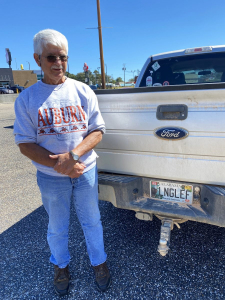
I’m grateful that Rhett and Emmett have dedicated their professional lives to endeavors like assuring that the Solon Dixon legacy lives on through future forestry and wildlife professionals.
When Judy and I visited the Center so long ago, our children were four and six years old. They will soon be 44 and 46. I am reminded of the words of Louis Bromfield, mid-20th-century novelist, who dedicated his life to rehabilitating his “old worn-out” Ohio Farm:
The land came to us out of eternity, and when the youngest of us associated with it dies, it will still be here. The best that any of us can hope to accomplish during our fleeting existence is to leave some small corner of the world better through wisdom, knowledge, and hard work.
I applaud Emmett and Rhett for their wisdom, knowledge, and hard work…and their unflagging passion!
Thoughts and Reflections
I offer these observations:
- I am hopelessly addicted to stories of passion for special places.
- And for special forest types, like longleaf pine.
- The best that any of us can hope to accomplish during our fleeting existence is to leave some small corner of the world better through wisdom, knowledge, and hard work.
Inhale and absorb Nature’s elixir. May Nature Inspire, Inform, and Reward you!
Note: All blog post images created & photographed by Stephen B. Jones unless otherwise noted. Please circulate images with photo credit: “©2022 Steve Jones, Great Blue Heron LLC. All Rights Reserved.”
Another Note: If you came to this post via a Facebook posting or by an another route, please sign up now (no cost… no obligation) to receive my Blog Post email alerts: http://eepurl.com/cKLJdL
And a Third: I am available for Nature-Inspired Speaking, Writing, and Consulting — contact me at steve.jones.0524@gmail.com
Reminder of my Personal and Professional Purpose, Passion, and Cause
If only more of us viewed our precious environment through the filters I employ. If only my mission and vision could be multiplied untold orders of magnitude:
Mission: Employ writing and speaking to educate, inspire, and enable readers and listeners to understand, appreciate, and enjoy Nature… and accept and practice Earth Stewardship.
Vision:
- People of all ages will pay greater attention to and engage more regularly with Nature… and will accept and practice informed and responsible Earth Stewardship.
- They will see their relationship to our natural world with new eyes… and will understand more clearly their Earth home.
Tagline/Motto: Steve (Great Blue Heron) encourages and seeks a better tomorrow through Nature-Inspired Living!
Steve’s Three Books
I wrote my books Nature Based Leadership (2016), Nature-Inspired Learning and Leading (2017), and Weaned Seals and Snowy Summits: Stories of Passion for Place and Everyday Nature (2019; co-authored with Dr. Jennifer Wilhoit) to encourage all citizens to recognize and appreciate that every lesson for living, learning, serving, and leading is either written indelibly in or is powerfully inspired by Nature.
I began writing books and Posts for several reasons:
- I love hiking and exploring in Nature
- I see images I want to (and do) capture with my trusty iPhone camera
- I enjoy explaining those images — an educator at heart
- I don’t play golf!
- I actually do love writing — it’s the hobby I never needed when my career consumed me
- Judy suggested my writing is in large measure my legacy to our two kids, our five grand kids, and all the unborn generations beyond
- And finally, perhaps my books and Blogs could reach beyond family and touch a few other lives… sow some seeds for the future

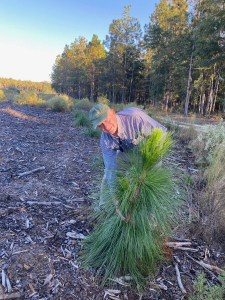
All three of my books (Nature Based Leadership; Nature-Inspired Learning and Leading; Weaned Seals and Snowy Summits) present compilations of personal experiences expressing my (and co-author Dr. Wilhoit for Weaned Seals and Snowy Summits) deep passion for Nature. All three books offer observations and reflections on my relationship to the natural world… and the broader implications for society. Order any and all from your local indie bookstore, or find them on IndieBound or other online sources such as Amazon and LifeRich.

